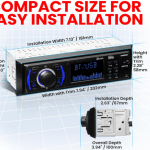In the world of car audio enthusiasts, achieving the perfect sound quality is a never-ending quest. If you own a 2003 BMW 325i and you’re looking to upgrade your car stereo system, one critical aspect to consider is the speaker size. In this guide, we’ll delve into the specifics of the 2003 BMW 325i speaker size and explore various related topics to help you make an informed decision for your car audio upgrade.
How Many Speakers Are in a 2003 BMW 325i?
When it comes to the audio system in your 2003 BMW 325i, it’s crucial to know the speaker configuration to make informed decisions about upgrades and replacements. In the 2003 BMW 325i, you can expect to find a total of eight speakers distributed throughout the vehicle. Here’s a breakdown of their locations:
Front Door Speakers: These are the primary speakers responsible for delivering crisp and clear midrange frequencies. In the 2003 BMW 325i, you’ll find a pair of 5.25-inch speakers located in the front doors.
Rear Deck Speakers: The rear deck houses another pair of speakers. These are 4-inch speakers designed to reproduce mid to high-frequency sounds.
Front Tweeters: To enhance the high-frequency range and provide better sound imaging, there are two tweeters mounted in the front dashboard or door panels.
Rear Tweeters: Similar to the front tweeters, there are two rear tweeters strategically placed in the rear interior panels to ensure a well-balanced audio experience for passengers in the back seats.
Understanding the distribution of these eight speakers is essential when planning any upgrades or modifications to your BMW 325i’s audio system. Whether you’re aiming to replace specific speakers for improved performance or considering a comprehensive audio system overhaul, knowing the speaker locations is the first step towards achieving your desired sound quality.
Understanding Your 2003 BMW 325i Speaker Size
Before diving into any audio upgrades, it’s essential to know the stock speaker sizes in your BMW 325i. The 2003 BMW 325i comes equipped with speaker sizes that are industry-standard for many vehicles. Typically, you’ll find:
Front Door Speakers: The front doors of your BMW 325i house 5.25-inch speakers. These speakers play a crucial role in delivering clear and vibrant midrange frequencies.
Rear Deck Speakers: In the rear deck, you’ll find 4-inch speakers. These speakers are responsible for reproducing the mid to high-frequency range, creating a balanced soundstage.
Now that you know the stock sizes, let’s explore some topics related to upgrading your car stereo system.
Upgrading Your BMW 325i Speaker System
Choosing the Right Speaker Size: If you’re aiming for a straightforward upgrade, you can replace your stock speakers with speakers of the same size. However, if you want to take your audio experience to the next level, consider upgrading to larger speakers for improved bass response and overall sound quality. Keep in mind that modifying the speaker size may require some customization to your vehicle’s mounting locations.
Component vs. Coaxial Speakers: When upgrading your speakers, you’ll come across two main types: component and coaxial (full-range) speakers. Component speakers provide superior sound quality by separating the speaker components (woofer, tweeter, and sometimes a midrange driver), while coaxial speakers combine all these elements in one unit. The choice depends on your audio preferences and budget.
Speaker Power Handling: Make sure to match the new speakers’ power handling capabilities with your car stereo or external amplifiers. Overpowering or underpowering your speakers can lead to distorted sound or damage over time.
Enhancing Sound Quality with Accessories
Amplifiers: Adding an amplifier to your car audio system can significantly improve the overall sound quality and allow you to achieve higher volume levels without distortion. Amplifiers come in various sizes and power ratings, so choose one that complements your speaker setup.
Sound Deadening Materials: To reduce road noise and improve the acoustic environment inside your car, consider installing sound deadening materials. These materials can make a noticeable difference in sound quality by minimizing vibrations and external noise interference.
Professional Installation vs. DIY
When it comes to upgrading your car stereo system, you have the option to either tackle the installation yourself or seek professional assistance. Here are some factors to consider:
DIY Installation: If you have experience with car audio installations and the necessary tools, you can save money by doing it yourself. However, ensure you follow the manufacturer’s instructions and take your time to avoid damaging your car’s interior or electrical systems.
Professional Installation: If you’re not comfortable with DIY work or you want a high-end, customized installation, hiring a professional car audio installer is a wise choice. They have the expertise and equipment to ensure a seamless and reliable upgrade.
Conclusion
Upgrading your 2003 BMW 325i’s speaker system can transform your driving experience, elevating your car audio to new heights. Whether you choose to stick with the stock speaker sizes or opt for a more significant upgrade, understanding your options and selecting the right components is essential. Additionally, accessories like amplifiers and sound deadening materials can further enhance your sound quality.
Before you embark on your car audio journey, carefully plan your upgrade, consider your budget, and decide whether you’ll tackle the installation yourself or enlist the help of a professional. With the right choices and a bit of effort, you’ll be cruising down the road with a car stereo system that delivers crystal-clear, immersive sound, making every drive a musical adventure.









